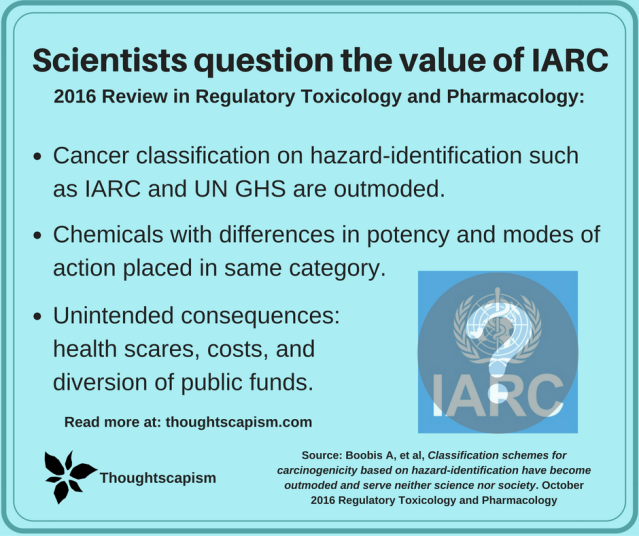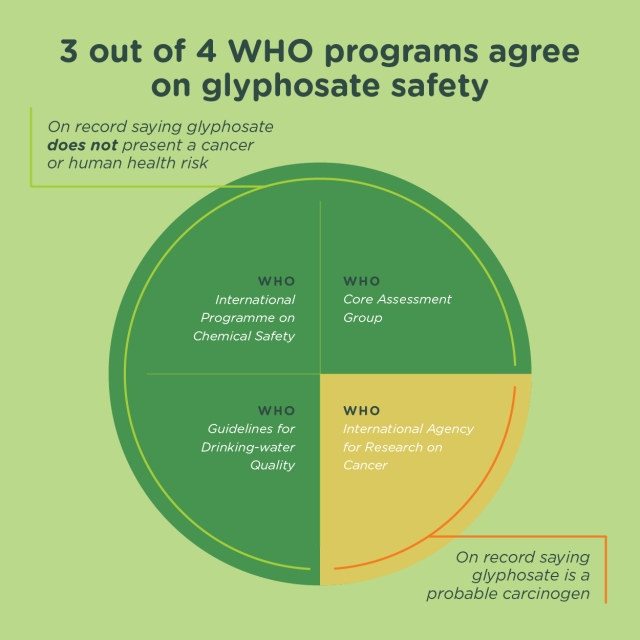Considering recently published scientific reviews on the International Agency on Cancer Research (IARC) concerning their methods and overall mission, as well as their specific conclusion on glyphosate, I thought the topic deserved an update of its own. I have written about glyphosate, cancer, and the IARC earlier, in my series 17 Questions on Glyphosate.
Much media and public attention has followed after World Health Organisation subgroup IARC has declared things like processed meat to be in the same class of cancer hazard as plutonium and tobacco, and red meat and glyphosate in the class 2A, “probably carcinogenic,” same slot where also fall “work as a hairdresser” or “manufacturing glass”. Apart from many sensationalist headlines, there has also been a fair amount of media criticism, like this in-depth piece from Reuters. What is confusing to many, is that IARC does not actually look at risk: how big is the risk for said carcinogenic effects? What levels are safe and what aren’t?
Many expert toxicologists have weighed in on the lack of scientific justification for the simplistic division of substances (and a wide array of other circumstances, such as occupations) into non-carcinogenic and carcinogenic, without consideration for drastically different levels of potency and modes of action. On top of that, there are also several concerning aspects about how the IARC handled the specifics around the review of several cases, such as meat, or cellphone radiation, as brought up in the Reuters piece, and particularly concerning glyphosate: they excluded much available evidence from the review, and misinterpreted results of some of the studies they did include.

Questionable selection and interpretation of studies
It has been questioned why the IARC excluded much of the existing reputable evidence, as they deemed decades of existing government studies to be of no significance, and excluded six reputable studies which did not find glyphosate to pose risk. The government regulatory bodies, however, are held accountable for public health questions, their experts spend months assessing each topic, compared to the seven days spent on each by IARC, and unlike the IARC, many of them are obligated to conduct periodic updates of their evaluations. It is strange for IARC to decide their evaluations to be of no value.
The IARC also made connections to human effects where the study authors themselves did not agree: toxicologist, Keith Solomon, condemns the way IARC interpreted a study he had personally published, which they claim to support that glyphosate would be genotoxic. Mr Solomon is quoted here saying the IARC’s research conclusions highly misinterpreted:
Keith Solomon, a University of Guelph professor emeritus and a globally recognized authority on pesticides, said the conclusion is “totally wrong.” Solomon should know because he wrote the Colombian study. “They stated there was evidence of genotoxicity and they quoted one paper to support that statement,” Solomon said.
“There’s no evidence that glyphosate is genotoxic.”
The Colombian study can be found here. Solomon has also published a recent review on glyphosate exposure levels based on data from the Environmental Protection Agency and UN Food and Agricultural Organisation, and concludes that glyphosate exposure is so low as to be well within the robust safety margins set by regulatory agencies:
All of these exposures are less than the reference dose and the acceptable daily intakes proposed by several regulatory agencies, thus supporting a conclusion that even for these highly exposed populations the exposures were within regulatory limits.
Political motives?
The other serious criticism of IARC comes from their political connections. The question has been raised whether there exist conflict of interest within the IARC, considering undisclosed connections to activist organisations seeking to paint pesticides in a uniformly negative light.
What is particularly concerning is the way these actors from IARC have used the classification system for political lobbying. A post on Applied Mythology highlights these political further in a piece titled The Shady Politics Of The IARC Glyphosate Hazard Assessment (piece temporarily down, meanwhile here the aggregate from GLP):
Individuals closely associated with IARC, such as Dr. Christopher Portier, have used the IARC’s findings to lobby against its use. For instance, Dr. Portier led a group of activists in a letter to the EU Commissioner for Health and Food Safety, suggesting that the IARC classification was more rigorous than that of the European Food Safety Administration’s (EFSA) classification of glyphosate and urging the Commissioner to “disregard the flawed EFSA finding on glyphosate.
In fact, Portier was the chairman of a 2014 IARC meeting to determine the organization’s priorities in research for the coming year, which incidentally included glyphosate. According to Reuters, Portier represented a conflict of interest for IARC due to his part time employment with the Environmental Defense Fund. Additionally, Portier did not disclose his EDF affiliation in the 2014 advisory group meeting mentioned below, at which glyphosate was scheduled for review.
According to the piece, IARC also declined the request from the WHO to change the name from the misleading ‘risk’ classification system to the more truthful ‘hazard’ classification.
Scientifically outdated methods
A new paper was just published in Regulatory Toxicology and Pharmacology, which criticizes IARC’s mission of simplistically dividing substances into carcinogenic or non-carcinogenic, without taking in consideration the degree and nature of exposure, Classification schemes for carcinogenicity based on hazard-identification have become outmoded and serve neither science nor society. The highlights of the paper are:
- Cancer classification on hazard-identification such as IARC and UN GHS are outmoded.
- Chemicals with differences in potency and modes of action placed in same category.
- Unintended consequences: health scares, costs, and diversion of public funds.
- Modern approaches based on hazard and risk characterization should be used.
- International initiative needed a consensus on for carcinogenicity.
UN GHS refers to Globally Harmonized System of Classification and Labelling of Chemicals. The expert toxicologists’ take on IARC’s methodology in the paper reads as follows:
Classification schemes for carcinogenicity based solely on hazard-identification such as the IARC monograph process and the UN system adopted in the EU have become outmoded. They are based on a concept developed in the 1970s that chemicals could be divided into two classes: carcinogens and non-carcinogens. Categorization in this way places into the same category chemicals and agents with widely differing potencies and modes of action.
Another review has been published in September, which summarizes the results from four panels of experts that have conducted a similar review of the evidence as the IARC:
Four Expert Panels have been convened for the purpose of conducting a detailed critique of the evidence in light of IARC’s assessment and to review all relevant information pertaining to glyphosate exposure, animal carcinogenicity, genotoxicity, and epidemiologic studies.
 The associations made by the IARC were found by these expert panels to be lacking in statistical strength and plausible mechanisms of action, and failed to show dose-response relationships. It is really quite striking to fail on so many accounts. These panels find no suggestion for how glyphosate might be carcinogenic, no findings of higher risks with higher exposures (suggesting causality), and no robust epidemiological correlations. With such absence of evidence, it really begs the question, why IARC thought it had grounds to make the opposite conclusion?
The associations made by the IARC were found by these expert panels to be lacking in statistical strength and plausible mechanisms of action, and failed to show dose-response relationships. It is really quite striking to fail on so many accounts. These panels find no suggestion for how glyphosate might be carcinogenic, no findings of higher risks with higher exposures (suggesting causality), and no robust epidemiological correlations. With such absence of evidence, it really begs the question, why IARC thought it had grounds to make the opposite conclusion?

Glyphosate breakdown product AMPA
The synthesis from the four panels of the review above on glyphosate, its breakdown product AMPA, and glyphosate-based formulations (GBFs) ends with:
the Panels concluded that the data do not support IARC’s conclusion that glyphosate is a “probable human carcinogen” and, consistent with previous regulatory assessments, further concluded that glyphosate is unlikely to pose a carcinogenic risk to humans.
As a European citizen, I have grown up looking up to the World Health Organisation as a reliable source of information on topics of global importance. Reading closer on many health and environmental topics, including those of the different sub-groups of the WHO, and the workings of the United Nations in general, I have realised that like any large organisation, it is not a stranger to internal politics. While its scope and track-record in many areas is commendable, the committees and conferences, and the numerous sub-topics it handles, are not immune to political influence. Political bias, coupled with simple human failings, may on occasion gain the upper hand of a subgroup or another, as sadly seems to be have been the case here with IARC.
For another example of veering from best scientific practice and strict reliance of evidence, I have previously written about a questionable report from the UN Conference on Trade and Development in the piece: Myth: UN Calls for Small-Scale Organic Farming.
Consensus on glyphosate on one side, IARC on the other
However, hopefully demonstrating that these kind of internal hiccups are still rare, most departments of the World Health Organisation – as well as the US EPA, and the German BfR, and the European Food Safety Authority – do reach a converging, evidence-based agreement on glyphosate: it is unlikely to cause any cancer risk to the public.

You can also read more here on Monsanto’s own page about IARC’s report on glyphosate.
I hope the health authorities over the globe will get the message. We need a clearly communicated consensus on cancer risk based on up-to-date scientific methodology that does not have the side-effect of creating needless scare campaigns. It would be detrimental to erode the public’s trust in national and international health organisations any further in this internet-age, where scare-tactics and complementary offers of alluringly simple, over-reaching solutions are among the easiest ways of catching the public’s attention.

Please see the parent post, 17 Questions About Glyphosate, for more information on connected topics. If you are interested in other environmental or health topics, you can find my other pieces and further resources under Farming and GMOs, The Environment, and Vaccines and Health. If you would like to have a discussion in the comments below, please take note of my Commenting policy. In a nutshell:
- Be respectful.
- Back up your claims with evidence.



Pingback: 1. Does Glyphosate Cause Cancer? | Thoughtscapism
Pingback: 1 of 17 – Does Glyphosate Cause Cancer? – GMO Building Blocks
Pingback: Risk In Perspective: Hazard and Risk Are Critically Different Things | Thoughtscapism
Pingback: Risk In Perspective: Hazard And Risk Are Different
Pingback: Chemical Exposures: The Good, the Bad, and the Tiny | Thoughtscapism